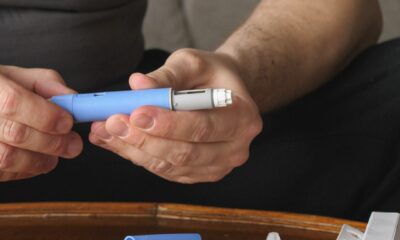Fat Loss
How Does Insulin Resistance Make You Gain Weight

Are you frustrated with stubborn weight gain that doesn’t seem to budge no matter how much you exercise or diet? Well, the culprit might just be insulin resistance. In this article, we’ll dive deep into the science behind the link between insulin resistance and weight gain, uncovering the root causes and exploring potential solutions. How To Stop Insulin Resistance Weight Gain?Insulin resistance occurs when your body’s cells become less responsive to the hormone insulin, which leads to elevated blood sugar levels.
But how does this relate to weight gain? It turns out that insulin plays a crucial role in regulating fat storage and metabolism. When insulin levels are consistently high due to resistance, it becomes harder for your body to burn fat for energy, leading to increased fat storage, especially around the abdomen.
Understanding the science behind insulin resistance and weight gain can help you take proactive steps to combat it. By implementing specific dietary and lifestyle changes, you can effectively reduce insulin resistance and improve your body’s ability to burn fat. Stay tuned to discover the science-backed strategies that can help you break through the weight loss plateau caused by insulin resistance.
Understanding Insulin Resistance
Certainly! Insulin resistance is a condition in which cells in the body become less responsive to the effects of insulin. Here’s a brief overview:
- Insulin’s Role: Insulin is a hormone produced by the pancreas. Its primary role is to help cells take in glucose (sugar) from the bloodstream and use it for energy.
- Resistance: With insulin resistance, the body’s cells don’t respond as effectively to insulin. As a result, the pancreas produces more insulin to compensate. Over time, this can lead to higher than normal levels of both insulin (hyperinsulinemia) and blood sugar (hyperglycemia).
- Consequences: If not managed, insulin resistance can progress to type 2 diabetes. The high blood sugar levels associated with diabetes can damage various organs and systems in the body, leading to complications like heart disease, kidney disease, and vision problems.
- Causes: Several factors can contribute to insulin resistance, including genetics, obesity, lack of physical activity, certain medications, and other conditions like polycystic ovary syndrome (PCOS). High levels of inflammation in the body and fat stored in the abdomen are also associated with increased risk.
- Symptoms: In its early stages, insulin resistance may not show clear symptoms. As it progresses, symptoms may include fatigue, hunger, difficulty concentrating, weight gain around the midsection, and darkened skin patches (acanthosis nigricans).
- Diagnosis: Insulin resistance can be detected through various tests. Common ones include the fasting blood sugar test, oral glucose tolerance test, and HbA1c test. These measure how your body processes glucose.
- Management: Lifestyle changes are key in managing insulin resistance. This includes adopting a balanced diet, engaging in regular physical activity, and maintaining a healthy weight. In some cases, medications might be prescribed to improve insulin sensitivity or control blood sugar levels.
- Prevention: While you can’t control all risk factors (like genetics), you can adopt a healthy lifestyle to reduce your risk. This means regular exercise, a balanced diet, avoiding excessive alcohol and sugar intake, and maintaining a healthy weight.
Understanding insulin resistance is crucial because it’s a significant precursor to many health issues, especially type 2 diabetes. If you believe you may be at risk, it’s essential to consult with a healthcare professional.
The Role of Insulin In Weight Management
Insulin plays a pivotal role in weight management due to its functions in regulating glucose metabolism and storage. Here’s a concise explanation:
- Glucose Uptake: Insulin helps cells in the body take in glucose from the bloodstream. Muscle and fat cells need insulin to absorb glucose, which they either use for energy or store for later.
- Storage of Excess Glucose: When there’s more glucose than the body needs immediately, insulin promotes the storage of excess glucose in the liver as glycogen. Once the liver’s glycogen storage capacity is reached, additional excess glucose is converted into fat.
- Fat Storage: Insulin also prevents the breakdown of fat in adipose tissue by inhibiting the activity of an enzyme known as hormone-sensitive lipase. Essentially, when insulin levels are high, it signals the body to store fat and use glucose for energy. Conversely, when insulin levels drop, it signals the body to break down fat and use it as a fuel source.
- Appetite Regulation: Insulin interacts with other hormones like leptin, which is produced by fat cells and plays a role in appetite regulation. Insulin resistance, where the body doesn’t respond well to insulin’s signals, can disrupt these hormonal pathways and potentially lead to increased hunger and weight gain.
- Weight Gain and Insulin Resistance: High insulin levels, often seen with a diet high in refined carbs and sugars, can contribute to weight gain. Over time, as the body becomes more resistant to insulin, the pancreas produces more insulin, creating a cycle of weight gain and increasing insulin resistance.
- Weight Management: A balanced diet that’s low in refined carbohydrates and sugars can help maintain stable blood sugar levels, leading to lower and more stable insulin levels. This can make it easier to manage or lose weight. Physical activity also increases insulin sensitivity, meaning the body requires less insulin to process glucose.
In summary, insulin is deeply intertwined with weight management due to its roles in glucose uptake, energy storage, fat storage, and appetite regulation. Balancing insulin levels through diet and lifestyle choices can significantly influence weight management outcomes.
How Insulin Resistance Leads To Weight Gain
Insulin resistance and weight gain are closely intertwined, often creating a cycle where one exacerbates the other. Here’s a concise breakdown of how insulin resistance can lead to weight gain:
- Inefficient Glucose Processing: With insulin resistance, cells don’t respond effectively to insulin’s signals to take up glucose from the bloodstream. As a result, the body needs to produce more insulin to compensate.
- Increased Insulin Levels: Higher circulating insulin levels (hyperinsulinemia) lead to reduced breakdown of stored fat for energy. When insulin levels are high, lipolysis (fat breakdown) is inhibited. This means the body primarily uses glucose for energy and stores more fat.
- Overcompensation by the Pancreas: As the body’s cells become more resistant to insulin, the pancreas tries to compensate by producing even more insulin. This exacerbates the issue, leading to further reduced fat burning and more fat storage.
- Increased Hunger: Insulin has a role in signaling satiety (fullness) in the brain. Insulin resistance can disrupt this signal, potentially leading to increased hunger and overeating.
- Liver Glucose Production: As insulin resistance progresses, the liver doesn’t respond as well to insulin’s signals to stop producing glucose. This results in increased blood sugar levels, which if not used for energy, can be converted into stored fat.
- Fat Storage in Unusual Places: With prolonged insulin resistance, fat can start being stored in places other than just adipose tissue, such as around organs (visceral fat). This type of fat storage is associated with further metabolic disturbances.
- Changes in Fat Storage Hormones: Insulin resistance can also influence other hormones related to fat storage and hunger, such as leptin, further promoting weight gain.
In essence, insulin resistance can promote weight gain by reducing the body’s ability to burn stored fat, increasing the conversion of excess glucose into fat, stimulating hunger, and causing a variety of hormonal changes that favor fat storage. It’s also worth noting that factors like a diet high in refined carbohydrates and sugars, sedentary behavior, and other lifestyle factors can both cause insulin resistance and be influenced by the consequences of it, creating a feedback loop that exacerbates the problem.
Common Symptoms Of Insulin Resistance
Insulin resistance often starts silently, meaning it might not present obvious symptoms immediately. However, as it progresses, several symptoms and signs can become evident. Here are some common symptoms and related indicators of insulin resistance:
- Higher Blood Sugar Levels: Over time, insulin resistance can lead to elevated fasting blood sugar levels, which can be detected through routine blood tests.
- Acanthosis Nigricans: Darkened, velvety patches of skin, especially around the neck, armpits, groin, and other body folds. This skin change is an external indicator of insulin resistance.
- Weight Gain: Especially around the midsection (abdominal obesity).
- Fatigue: Feeling tired or exhausted despite adequate sleep can sometimes be related to insulin resistance due to the inefficiency in glucose utilization.
- Hunger: Increased hunger, especially shortly after eating, can be a symptom as the body’s cells aren’t efficiently absorbing glucose from the bloodstream.
- Difficulty Concentrating: Sometimes referred to as “brain fog,” this can occur due to unstable blood sugar levels.
- High Blood Pressure: While not a direct symptom, there’s a correlation between insulin resistance and elevated blood pressure in many individuals.
- High Cholesterol: Particularly a rise in triglycerides and a decrease in HDL (the “good” cholesterol) can be associated with insulin resistance.
- Polycystic Ovary Syndrome (PCOS): Women with PCOS often have insulin resistance as one of the underlying metabolic disturbances.
- Frequent Infections: Elevated blood sugar levels can lead to recurrent infections, such as yeast infections or urinary tract infections.
- Slow Healing: Wounds, cuts, or bruises might take longer than usual to heal.
It’s essential to note that having one or more of these symptoms does not definitively mean someone has insulin resistance. However, if you suspect you might have it due to the presence of several symptoms, it’s crucial to see a healthcare professional for a proper assessment and potential intervention.
Diagnosing Insulin Resistance
Diagnosing insulin resistance is typically based on a combination of clinical findings, patient history, and laboratory tests. Here’s how the process usually unfolds:
- Clinical Evaluation: A healthcare provider will start by assessing risk factors and signs of insulin resistance. These might include obesity (particularly abdominal obesity), a family history of type 2 diabetes, and physical signs like acanthosis nigricans (dark, velvety patches of skin).
- Fasting Blood Sugar Test: After an overnight fast, a blood sample is taken to measure fasting blood glucose levels. Elevated levels might indicate insulin resistance or diabetes.
- Oral Glucose Tolerance Test (OGTT): After fasting, you’ll consume a drink containing a specific amount of glucose. Blood sugar levels are then measured at intervals, typically at 2 hours after the drink. If your blood sugar level is higher than normal but not high enough to diagnose diabetes, it indicates prediabetes, a condition often associated with insulin resistance.
- Hemoglobin A1c (HbA1c) Test: This test provides an average of blood sugar levels over the past 2-3 months. Elevated levels can suggest insulin resistance or diabetes.
- Insulin Level and C-Peptide Test: These blood tests measure the amount of insulin and C-peptide (a byproduct of insulin production) in your blood. Higher levels can indicate that your body is producing more insulin to compensate for resistance.
- Homeostatic Model Assessment for Insulin Resistance (HOMA-IR): This is a calculation using fasting glucose and insulin levels to estimate insulin resistance. A higher HOMA-IR score typically indicates greater insulin resistance.
- Lipid Profile: Insulin resistance can affect cholesterol and triglyceride levels. A lipid profile might show high triglycerides and low HDL (“good” cholesterol).
- Clinical Context: Insulin resistance often coexists with other conditions like hypertension, polycystic ovary syndrome (PCOS), or non-alcoholic fatty liver disease (NAFLD). Diagnosing these conditions can provide additional context for suspected insulin resistance.
No single test can definitively diagnose insulin resistance, and often a combination of tests and clinical judgment is used. If you or someone you know suspects they have insulin resistance, it’s essential to consult a healthcare professional who can guide appropriate testing and provide recommendations based on the results.

Strategies For Managing Insulin Resistance And Weight Gain
Managing insulin resistance and associated weight gain requires a multifaceted approach, focusing on lifestyle changes, possibly medications, and continuous monitoring. Here are some effective strategies:
- Dietary Changes:
- Low Glycemic Load: Focus on foods that have a lower glycemic index, meaning they cause a slower, steadier rise in blood sugar. Examples include whole grains, legumes, vegetables, and some fruits.
- Limit Refined Carbs and Sugars: Reduce intake of white bread, pastries, sodas, and other highly processed or sugary foods.
- Increase Fiber: Fiber can help improve blood sugar control. Opt for vegetables, fruits, legumes, and whole grains.
- Healthy Fats: Include sources of omega-3 and monounsaturated fats like fish, avocados, nuts, and olive oil. Limit trans fats and saturated fats.
- Physical Activity:
- Engage in at least 150 minutes of moderate-intensity aerobic exercise per week, like brisk walking, cycling, or swimming.
- Include strength training exercises 2-3 times per week.
- Regular exercise can help improve insulin sensitivity.
- Weight Management:
- Even a modest weight loss (5-10% of body weight) can improve insulin resistance.
- Work with a nutritionist or dietician for personalized guidance.
- Medications:
- Metformin (Glucophage): Often prescribed for type 2 diabetes, it can also be used to improve insulin sensitivity in those with insulin resistance.
- Other medications might be recommended based on individual needs and accompanying health conditions.
- Sleep:
- Aim for 7-9 hours of quality sleep per night. Poor sleep can worsen insulin resistance.
- Stress Management:
- Chronic stress can elevate cortisol levels, which can exacerbate insulin resistance. Incorporate relaxation techniques like meditation, deep breathing, or yoga.
- Regular Monitoring:
- Regularly monitor blood glucose levels to ensure they remain in a healthy range.
- Periodic hemoglobin A1c tests can provide an overview of long-term blood sugar control.
- Limit Alcohol:
- If consumed, do so in moderation. Excessive alcohol can disrupt blood sugar control.
- Avoid Smoking:
- Smoking can exacerbate insulin resistance. Seek support if trying to quit.
- Stay Informed:
- New research and strategies for managing insulin resistance are continuously emerging. Staying informed can help adapt to the most effective strategies.
Working closely with healthcare professionals can help tailor the best approach to managing insulin resistance and associated weight gain for individual needs. They can provide guidance, track progress, and adjust strategies as required How To Stop Insulin Resistance Weight Gain.
The Importance Of A Balanced Diet And Exercise Insulin Resistance
A balanced diet and regular exercise play pivotal roles in preventing and managing insulin resistance. Their combined benefits target the underlying mechanisms and consequences of this condition. Here’s why they’re so crucial:
- Glycemic Control:
- Balanced Diet: Consuming foods with a low to moderate glycemic index helps maintain stable blood sugar levels. Stable blood sugar reduces the demand for insulin, alleviating the stress on pancreatic beta cells and reducing hyperinsulinemia.
- Exercise: Physical activity enhances muscle glucose uptake, which can help lower blood glucose levels without relying heavily on insulin.
- Improved Insulin Sensitivity:
- Balanced Diet: A diet rich in whole foods, fiber, healthy fats, and lean proteins can improve cellular responsiveness to insulin.
- Exercise: Regular physical activity promotes better insulin sensitivity. Muscles become more efficient at using available insulin to absorb glucose during and after activity.
- Weight Management:
- Balanced Diet: Proper nutrition supports healthy weight management. Excess body fat, especially visceral fat, is associated with increased insulin resistance.
- Exercise: It helps burn calories and build lean muscle mass, which aids in weight loss and maintenance. Losing even a modest amount of weight can significantly improve insulin sensitivity.
- Metabolic Benefits:
- Balanced Diet: Provides essential nutrients that support overall metabolic health, including vitamins, minerals, and antioxidants that can reduce inflammation—a known factor in insulin resistance.
- Exercise: Enhances metabolic flexibility, meaning the body can switch between using carbs and fats as energy sources more efficiently.
- Heart Health:
- Balanced Diet: Foods rich in omega-3s, fiber, and antioxidants can improve lipid profiles and blood pressure, reducing cardiovascular risk associated with insulin resistance.
- Exercise: Regular activity strengthens the heart, improves blood circulation, and can help normalize blood pressure and cholesterol levels.
- Mental Well-being:
- Balanced Diet: Proper nutrition supports brain health, mood regulation, and can reduce the risk of mood disorders.
- Exercise: Releases endorphins, which are natural mood boosters. It can also help with stress management, a factor that can exacerbate insulin resistance.
- Hormonal Balance:
- Balanced Diet: Supports balanced hormone production and can mitigate the effects of conditions related to insulin resistance, like PCOS.
- Exercise: Helps regulate hormones that influence appetite, stress, and metabolic health.
In summary, a balanced diet and exercise act synergistically to combat insulin resistance from multiple angles. By addressing both the root causes and the downstream effects, these lifestyle factors are foundational in managing and potentially reversing insulin resistance.
Medication & Suplements For Insulin Resistance And Weight Mangement
You will get many questions on weight problems like How To Stop Insulin Resistance Weight Gain? If you suspect insulin resistance or are trying to manage weight, it’s essential to work closely with a healthcare provider. They can help determine the most suitable medications and supplements for your specific situation. Here’s a list of commonly used medications and supplements:
Medications:
- Metformin (Glucophage): This is the most commonly prescribed drug for insulin resistance, often used in type 2 diabetes. It improves the sensitivity of tissues to insulin and decreases liver glucose production.
- Thiazolidinediones (TZDs): Examples include pioglitazone (Actos) and rosiglitazone (Avandia). These drugs increase insulin sensitivity in fat and muscle and inhibit liver glucose production.
- GLP-1 Receptor Agonists: Drugs like liraglutide (Victoza, Saxenda) and exenatide (Byetta, Bydureon) mimic the action of the body’s incretin hormones, which help lower post-meal blood sugar levels.
- SGLT2 Inhibitors: Such as empagliflozin (Jardiance) and dapagliflozin (Farxiga) work by increasing glucose excretion in urine.
- Alpha-glucosidase inhibitors: Medications like acarbose (Precose) slow the digestion of carbohydrates, reducing the rise in blood sugar after meals.
Supplements:
- Chromium: It is believed to enhance the action of insulin and is sometimes used to improve glucose control. However, studies on its efficacy have been mixed.
- Magnesium: Some studies suggest that magnesium supplementation might improve insulin sensitivity.
- Berberine: A compound found in several plants and has been shown in some studies to have effects similar to metformin.
- Alpha-lipoic acid: An antioxidant that might enhance the body’s response to insulin.
- Omega-3 Fatty Acids: Found in fish oil, they can improve lipid profiles and might have modest benefits in insulin resistance.
- Green Tea Extract: Contains polyphenols that might help in modest weight loss and improve insulin sensitivity.
- Cinnamon: Some studies suggest that cinnamon can improve insulin sensitivity, but results are mixed.
- Inositol: Especially in the form of myo-inositol, has been researched for its potential benefits in conditions like PCOS and associated insulin resistance.
Remember, while medications can be effective, they can also come with side effects. Supplements, too, can interact with other medications and conditions. It’s essential to consult with a healthcare professional before starting any new treatment or supplement to ensure safety and appropriateness for your health situation.

Lifestyles Changes To Improve Insulin Sensitivity and Promote Weight Loss
Improving insulin sensitivity and promoting weight loss largely depends on adopting certain lifestyle changes. Here are some practical and effective strategies:
- Dietary Adjustments:
- Whole Foods: Emphasize whole, unprocessed foods like vegetables, fruits, lean proteins, whole grains, and healthy fats.
- Limit Refined Carbs: Reduce intake of sugars, sodas, and processed foods that spike blood sugar levels.
- Portion Control: Pay attention to serving sizes to avoid overeating.
- Increase Fiber: Consuming more fiber can help regulate blood sugar and promote satiety.
- Stay Hydrated: Drink plenty of water throughout the day.
- Limit Alcohol: If consumed, do so in moderation.
- Physical Activity:
- Regular Exercise: Engage in a mix of aerobic (e.g., walking, running, swimming) and anaerobic (e.g., weight lifting) exercises.
- Stay Active: Incorporate more daily movement, like taking stairs, walking during breaks, or using a standing desk.
- Consistency: Aim for at least 150 minutes of moderate-intensity exercise or 75 minutes of vigorous-intensity exercise every week.
- Sleep:
- Aim for 7-9 Hours: Consistent, quality sleep is vital for hormonal balance and recovery.
- Sleep Hygiene: Maintain a regular sleep schedule, create a calming bedtime routine, and ensure a dark, cool bedroom environment.
- Stress Management:
- Mindfulness: Practices such as meditation, deep breathing exercises, and yoga can help manage stress.
- Breaks: Take regular breaks during work or study sessions.
- Hobbies: Engage in activities you enjoy, like reading, gardening, or crafting.
- Limit Toxins:
- Avoid Smoking: It can exacerbate insulin resistance.
- Limit Exposure: Reduce exposure to environmental toxins, including certain chemicals in plastics, cosmetics, and pesticides.
- Monitor Health:
- Regular Check-ups: Visit your healthcare provider regularly for check-ups, blood tests, and health assessments.
- Self-monitoring: If advised, use a glucometer to check your blood sugar levels at home.
- Healthy Mindset:
- Stay Positive: Adopt a growth mindset, focusing on progress rather than perfection.
- Seek Support: Engage with support groups, therapists, or counselors if you feel overwhelmed or discouraged.
- Limit Sedentary Behavior:
- Move Regularly: Set reminders to get up and move every hour, especially if you have a desk job.
- Active Leisure: Opt for activities like walking, cycling, or playing a sport instead of sedentary pastimes.
- Stay Informed:
- Educate Yourself: Understand the basics of nutrition, exercise, and their impact on insulin sensitivity.
- Stay Updated: New research and strategies for managing insulin sensitivity are continuously emerging. Staying informed can help you adapt and optimize your approach.
Making these changes requires commitment, but the benefits in terms of improved health, energy, and well-being can be substantial. Remember that everyone’s journey is unique, so it’s essential to find what works best for you and make adjustments as needed.
Conclusion: Taking Control Of Your Health With Knowledge About Insulin Resistance & Weight Gain
In conclusion, taking control of your health by understanding insulin resistance and its connection to weight gain is a powerful and proactive step toward a healthier future. Knowledge is your ally in this journey. By comprehending the underlying mechanisms and the impact of lifestyle choices, you can make informed decisions to manage and even reverse insulin resistance. Here are some key takeaways how to stop insulin resistance weight gain:
- Awareness: Knowing the signs and symptoms of insulin resistance is the first step in addressing the issue. Early recognition can prevent its progression to more severe health conditions.
- Lifestyle Matters: Diet and exercise are foundational to managing insulin resistance and achieving weight loss. A balanced diet and regular physical activity help regulate blood sugar, improve insulin sensitivity, and support overall well-being.
- Consult with Professionals: Working with healthcare providers, nutritionists, and fitness experts can provide personalized guidance and ensure your approach is tailored to your specific needs and circumstances.
- Regular Monitoring: Periodic health check-ups and monitoring of blood sugar levels are essential to track progress and make necessary adjustments.
- Holistic Approach: Addressing insulin resistance is not only about physical health but also mental well-being. Stress management, adequate sleep, and a positive mindset play crucial roles.
- Personalized Strategies: Every individual is unique, and there’s no one-size-fits-all solution. Experiment with different dietary and exercise approaches to find what works best for you.
- Stay Informed: Be open to learning and adapting. Health science continually evolves, and staying informed allows you to make informed choices about your well-being.
Taking control of your health is an empowering journey that can lead to better quality of life, increased energy, and reduced risk of chronic diseases. By gaining knowledge and applying it to your daily life, you have the opportunity to make significant positive changes and enjoy a healthier future.
Blog
Fat Loss Clinic in Pakistan
Have you tried multiple weight loss methods but still struggle with stubborn fat that won’t go away? You’re not alone. Many people in Pakistan’s major cities like Islamabad, Rawalpindi, Lahore, and Karachi face the same problem — spending time and money on weight loss plans that yield no permanent results.
But here’s the real question: Why doesn’t your fat decrease even with treatment?
The answer is often linked to improper treatment plans, unqualified practitioners, or compromised fat loss procedures done at lower costs.
To achieve visible, long-lasting results, you need a qualified fat loss specialist, appropriate techniques, and a realistic treatment investment at a trusted clinic.
Best Fat Loss Treatments in Pakistan – Now Available at Aesthsurge Clinic Rawalpindi
At Aesthsurge Clinic in Rawalpindi, patients receive advanced non-surgical weight loss and body contouring treatments tailored to their body type and goals. Whether you’re dealing with belly fat, love handles, or double chin, professional-grade fat dissolving injections and other therapies can help you reduce and reshape effectively.
Do Fat Dissolving Injections Work?
Yes! Fat dissolving injections are clinically proven to break down and eliminate stubborn fat cells from targeted areas. These injections work by destabilizing the fat cell membrane and triggering the body to naturally eliminate fat through the lymphatic system.
Common treatment areas include:
- Double Chin
- Neck and Jawline
- Abdomen (Tummy)
- Hips & Love Handles
- Thighs
- Upper Arms
- Back Folds
- Chest (for men)
How Fat Dissolving Injections Work
These injections contain Deoxycholic Acid, a naturally occurring substance in the body that helps break down fat. When injected into fatty areas in higher concentration, the fat cells are destroyed and flushed out naturally.
Two Well-Known Brands:
- Kybella® (FDA Approved) – Ideal for double chin and jawline
- Aqualyx® (EU Certified) – Ideal for larger body areas like waist, thighs, arms
Treatment Benefits
- Non-surgical & minimally invasive
- No general anesthesia or cutting required
- Visible results after 1–3 sessions
- Targets stubborn fat that diet and exercise can’t
- Boosts skin firmness in some areas (Aqualyx effect)
How Many Sessions Are Needed?
The number of sessions depends on the size of the area and fat volume:
- Small areas (e.g., chin): 2–3 sessions
- Larger areas (e.g., thighs, belly): 4–6 sessions
- Gap between sessions: 2–3 weeks
How Long Do Results Last?
Fat cells destroyed during the procedure are permanently removed. However, maintaining a healthy lifestyle and exercise routine is essential to prevent new fat cells from forming.
What is Aqualyx?
Aqualyx is a modified form of deoxycholic acid developed for body contouring. When injected, it liquefies fat cells, which are then expelled through the body’s natural drainage system (lymphatic system).
Areas Treated with Aqualyx:
- Double Chin
- Arms & Armpits
- Abdomen & Love Handles
- Hips & Saddlebags
- Thighs & Knees
- Chest (for men)
- Back folds
Is It Safe?
Yes. When administered by a qualified practitioner, side effects are minimal and temporary, such as:
- Mild swelling and redness (3–5 days)
- Tenderness or bruising
- Temporary discomfort or numbness
Not Recommended For:
- Pregnant or breastfeeding women
- Individuals with autoimmune disorders
- People with liver or kidney conditions
Post-Treatment Care
- Avoid touching or massaging the area for 6 hours
- No steam baths, saunas, or high-heat exposure for 1 week
- Stay hydrated to aid fat elimination
- Avoid intense physical activity for 48–72 hours
Key Differences: Kybella vs. Aqualyx
| Feature | Kybella | Aqualyx |
|---|---|---|
| Approval | FDA Approved | CE Certified (EU) |
| Best for | Chin, Jawline | Body Contouring |
| Fat Removal | Deoxycholic Acid (Synthetic) | Deoxycholic Acid (Modified) |
| Skin Tightening | Mild | Moderate |
| Injection Areas | Face/Neck | Arms, Abdomen, Thighs |
Cost of Fat Dissolving Injections in Pakistan
The average price of fat dissolving injections in Islamabad and Rawalpindi ranges between:
- PKR 35,000 to 45,000 per session
The total cost depends on:
- Size of the treatment area
- Number of sessions required
- Clinic reputation and location
Frequently Asked Questions (FAQs)
Q1: Is this a weight loss treatment?
A: No. This is a body contouring procedure. It targets fat pockets, not overall body weight.
Q2: Is the fat removal permanent?
A: Yes, fat cells are permanently destroyed. But you need a healthy lifestyle to maintain results.
Q3: Are these injections painful?
A: Most patients report minimal discomfort. A local anesthetic or numbing cream is used during the procedure.
Q4: How soon will I see results?
A: Some patients see changes within 3 weeks, with full results visible in 6–8 weeks.
Q5: Can I return to work after the procedure?
A: Yes, downtime is minimal. You can resume normal activities within a day or two.
Why Choose Aesthsurge Clinic Rawalpindi?
- ✅ Non-surgical, FDA-compliant fat reduction techniques
- ✅ Certified aesthetic professionals with experience in body contouring
- ✅ Customized plans according to body type and fat distribution
- ✅ Comfortable and hygienic treatment environment
- ✅ Transparent pricing and genuine treatment approach
Ready to Sculpt Your Body Without Surgery?
Book a personalized consultation today at Aesthsurge Clinic Rawalpindi and take the first step toward a slimmer, sculpted you. Say goodbye to stubborn fat with advanced, doctor-supervised fat dissolving treatments.
👉 Visit Aesthsurge Clinic Rawalpindi – Start Your Transformation Now
Fat Loss
IV Therapy For Weight Loss Solution in Pakistan
Are you skeptical about the effectiveness of IV therapy for weight loss? Does it sound too good to be true?
Let’s break it down. IV therapy isn’t a magic solution—but when paired with a healthy diet, regular exercise, and lifestyle changes, it can be a powerful tool in your weight loss journey.
What is IV Weight Loss Therapy?
At Aesthesurge Clinic & Hospital in Islamabad, IV therapy for weight loss is a modern, non-surgical treatment that delivers a blend of essential vitamins, minerals, and fat-burning compounds directly into your bloodstream.
These nutrients help boost metabolism, support fat breakdown, and restore nutrient balance—all of which play vital roles in sustainable weight management.
Who Is It For?
- Individuals struggling to lose weight despite exercise and diet.
- People facing metabolic slowdown due to age, stress, or sedentary lifestyles.
- Those with nutrient deficiencies that hinder weight loss.
- Patients experiencing low energy or poor digestion.
If you’re battling stubborn fat or feeling sluggish and low on energy, IV therapy may be the jumpstart your body needs.
How Does IV Therapy Help with Weight Loss?
This therapy delivers a custom formula of lipotropic compounds and hydrating nutrients that:
- Enhance metabolic rate
- Support liver detoxification
- Aid in fat-to-energy conversion
- Improve cellular hydration
- Promote lean muscle mass
By improving these key functions, your body becomes more efficient in burning calories and eliminating toxins, resulting in better weight control and overall vitality.
Key Ingredients in the IV Weight Loss Drip
Here’s a breakdown of what goes into the treatment:
- Lipotropic Nutrients – Break down fat and encourage lean muscle.
- Vitamin B12 & B Complex – Boost metabolism, energy levels, and mental clarity.
- Vitamin C & D – Support immunity, fat oxidation, and hormonal balance.
- L-Carnitine – Converts stored fat into energy and enhances endurance.
- Taurine – Supports stress response, focus, and fat processing.
- Glutathione – A powerful antioxidant for detoxification and tissue repair.
- Magnesium & Biotin – Aid in energy production, fat metabolism, and nerve function.
- IV Fluids – Hydrate the body, reducing fatigue and aiding nutrient absorption.
What IV Therapy Can Do:
✔️ Increase energy levels
✔️ Support natural detoxification
✔️ Boost metabolism
✔️ Improve blood circulation
✔️ Enhance mood and focus
✔️ Assist in breaking down stubborn fat
What It Can’t Do:
✖️ Replace a balanced diet
✖️ Act as a cure for obesity
✖️ Substitute for physical activity
✖️ Deliver permanent results on its own
IV weight loss therapy is complementary, not a replacement for healthy habits.
Who Should Consider IV Weight Loss Treatment?
You may benefit from this therapy if you:
- Are just starting a weight loss plan
- Are struggling to burn fat in specific areas
- Have low energy or slowed metabolism
- Work a desk job and experience inactivity-related weight gain
- Frequently feel bloated, fatigued, or low on motivation
Potential Side Effects of IV Weight Loss Therapy
Although generally safe, some individuals may experience:
- Mild bruising at the injection site
- Dizziness or headache after infusion
- Temporary fatigue
- Allergic reactions (rare – always consult a healthcare professional)
Every treatment plan at Aesthesurge is customized and supervised to ensure safety and efficacy.
When Will You See Results?
Results vary based on body type, lifestyle, and consistency. While some patients notice increased energy and better digestion after a few sessions, long-term weight loss requires combining IV therapy with proper nutrition and exercise.
Book Your Consultation at Aesthesurge
Our expert team at Aesthesurge Clinic & Hospital in Islamabad is here to help you evaluate your needs and personalize your weight loss IV therapy plan.
Fat Burning Medications
Should You Follow Natural Ways To Lose Weight
Are you tired of restrictive diet plans and rigorous gym routines? If you’ve been struggling to lose weight without seeing lasting results, it’s time to explore natural weight loss remedies. These home treatments are simple, cost-effective, and often rely on ingredients already in your kitchen. Say goodbye to fad diets and hello to sustainable health with these proven strategies.
Why Natural Weight Loss Remedies Work
Natural remedies focus on nourishing the body, maintaining metabolic health, and avoiding the yo-yo effect caused by crash diets. Unlike extreme regimens, these methods offer gradual, sustainable weight reduction by enhancing digestion, metabolism, hydration, and mindful eating.
1. Start Your Day with Honey Lemon Water
A classic home remedy to boost metabolism and detoxify the body:
- Mix 2 teaspoons of honey and lemon juice in a glass of warm water.
- Drink on an empty stomach daily.
- This concoction supports fat breakdown and improves digestion naturally.
2. Spice Blend: Carom, Black Cumin, and Fenugreek
These Ayurvedic ingredients are powerful in their combined effect:
- Fenugreek (Methi) boosts metabolism.
- Carom (Ajwain) aids digestion.
- Black cumin (Kalonji) targets belly fat.
Grind equal parts of each after dry roasting and consume a teaspoon with warm water every morning.
3. Cinnamon and Honey Infusion
Curbs sugar cravings and stabilizes insulin levels:
- Boil water and add 2 cinnamon sticks and 1 teaspoon of honey.
- Consume lukewarm on an empty stomach.
- Enhances fat metabolism and regulates blood sugar.
4. Chewing Raw Garlic Daily
Despite the strong taste, chewing 2 cloves of raw garlic daily enhances fat-burning processes and supports cardiovascular health.
Tip: Brush your teeth after to avoid lingering odor.
5. Eliminate Artificial Sugars
Refined sugars are a major contributor to weight gain. Instead:
- Use natural sugars from fruits and vegetables like carrots, onions, and pumpkins.
- Avoid sweets, aerated drinks, and processed snacks.
6. Hydration: The Overlooked Fat Burner
Water helps with detoxification and fat metabolism:
- Calculate your ideal intake: Body weight (kg) ÷ 30 = liters/day.
- E.g., 65 kg = approx. 2.1 liters/day.
Staying hydrated boosts energy and curbs false hunger signals.
7. Sleep: The Metabolism Regulator
A consistent 8-hour sleep cycle enhances:
- Hormonal balance
- Metabolic rate
- Appetite regulation
Inadequate sleep often triggers cravings and slows weight loss.
8. Small Plate Strategy: The Psychology of Eating
Your brain is tricked into thinking you’re eating more when you use smaller plates:
- Reduces portion size naturally.
- Prevents overeating without conscious effort.
9. Frequent Mini Meals
Eating every 3–4 hours keeps blood sugar stable and curbs hunger:
- Helps avoid bingeing during main meals.
- Keeps metabolism active throughout the day.
10. Go Raw (with Precaution)
Raw vegetables like carrots, spinach, lettuce, and tomatoes are:
- High in fiber
- Low in calories
- Great for digestion and detox
Always opt for organic produce to avoid pesticide intake.
11. Mindful Eating: Chew Thoroughly
Proper chewing helps:
- Trigger fullness cues
- Aid digestion
- Reduce portion size
Take time to chew each bite at least 20–30 times.
12. Choose Whole Grains Over Refined Flour
Refined carbs like maida are empty calories. Instead, go for:
- Whole wheat flour (Atta)
- Brown rice
- Oats or quinoa
These high-fiber grains support longer satiety and stable energy.
13. Quit Smoking to Boost Weight Loss
Smoking reduces physical stamina and metabolism. Quitting helps:
- Restore lung and heart health
- Enhance physical activity levels
- Improve overall well-being
14. Stress Management Is Key
Chronic stress increases cortisol, leading to weight gain:
- Practice meditation, yoga, or deep breathing.
- Schedule regular breaks or vacations.
- Focus on enjoying the present.
15. Yogurt: Gut-Friendly and Satiating
Unsweetened yogurt supports:
- Gut health with probiotics
- Satiety without adding excess calories
- Use in smoothies or as a salad dressing
Quick Reminders That Support Weight Loss
- Never skip breakfast.
- Eat at fixed times daily.
- Avoid junk food – don’t even buy it.
- Exercise daily, even if just walking or stretching.
Natural Juices for Fat Loss
Here are 4 effective weight-loss-friendly juice recipes:
- Green Juice: Kale, cucumber, green apple, celery, lemon, and ginger.
- Watermelon Juice: Watermelon, lemon, and mint.
- Apple Zinger: Apple, lemon, ginger, cayenne.
- Veggie Detox: Tomato, carrot, beetroot, spinach, celery, garlic.
These juices are low in calories, rich in antioxidants, and promote hydration.
Avoid Crash Diets: They Don’t Work Long-Term
- Fasting or fruit-only diets shrink fat cells temporarily but don’t eliminate them.
- Once the routine is stopped, fat cells regain volume.
- Real change happens when fat cells are destroyed, not just reduced.
Permanent Fat Loss with Fat-Dissolving Injections (FDIs)
While natural remedies are excellent for sustainable health, if you’re considering advanced options like fat-dissolving injections (e.g., Kybella, Aqualyx), it’s essential to:
- Choose safe, certified treatments.
- Understand that these permanently eliminate fat cells from your body.
- Unlike diet-only methods, fat cells don’t return post-FDI.
FDIs also help in inch loss and sculpting, without burdening your kidneys or liver.
Top Home Workouts to Support Weight Loss
Balance your natural diet with home-friendly workouts like:
- HIIT: 20–30 minutes of intense intervals.
- Bodyweight circuits: Push-ups, squats, mountain climbers.
- Yoga & Pilates: Flexibility and core strength.
- Jump rope: High calorie-burn with little space needed.
- Stair workouts: Step-ups, stair runs.
Consistency, not intensity, is key to long-term results.
So, Should You Follow Natural Ways to Lose Weight?
Absolutely. Natural methods encourage balance, awareness, and long-term health. While quick fixes shrink fat cells temporarily, they don’t address the root causes or eliminate the fat structure. Only permanent solutions like FDIs can fully remove fat cells.
But whether you choose natural remedies or clinical solutions, the path to weight loss begins with informed decisions and consistent effort.
Ready to Take Control of Your Weight?
Whether you’re considering natural weight loss or safe fat-dissolving options, take the next step toward your transformation.
Contact Aesthedoc Clinic today at +92 333 7277272 and begin your journey to a healthier, more confident you.
-

 Blog11 months ago
Blog11 months agoFace Lift in Islamabad
-

 Blog8 months ago
Blog8 months agoLaser Skin Tightening in Rawalpindi Islamabad Lahore
-

 Blog3 months ago
Blog3 months agoMounjaro Price in Pakistan
-

 Blog8 months ago
Blog8 months agoPRP Stem Cell Exosomes in Pakistan AestheSurge
-

 Blog8 months ago
Blog8 months agoHymen Repair Surgery Treatment Results in Pakistan
-

 Blog8 months ago
Blog8 months agoMicroneedling Treatment Cost in Pakistan AestheSurge
-
Blog2 years ago
Weight Loss Injections, Saxenda Injection Treatment Price in Pakistan
-

 Blog8 months ago
Blog8 months agoHIFU Treatment Cost in Pakistan
